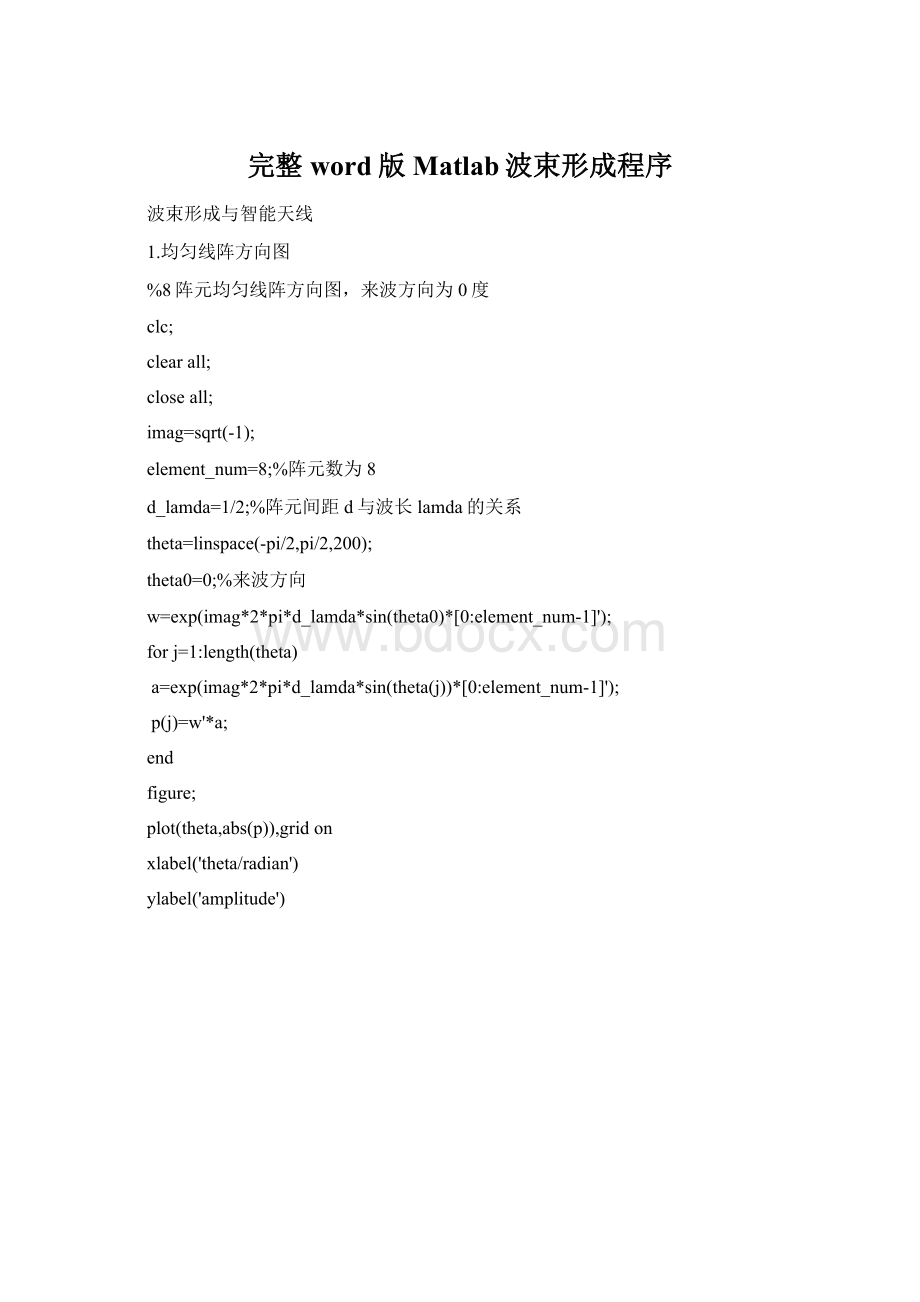完整word版Matlab波束形成程序Word文档下载推荐.docx
《完整word版Matlab波束形成程序Word文档下载推荐.docx》由会员分享,可在线阅读,更多相关《完整word版Matlab波束形成程序Word文档下载推荐.docx(27页珍藏版)》请在冰豆网上搜索。

a=exp(imag*2*pi*d_lamda*sin(theta(j))*[0:
p(j)=w'
*a;
end
figure;
plot(theta,abs(p)),gridon
xlabel('
theta/radian'
)
ylabel('
amplitude'
title('
8阵元均匀线阵方向图'
当来波方向为45度时,仿真图如下:
8阵元均匀线阵方向图如下,来波方向为0度,20log(dB)
随着阵元数的增加,波束宽度变窄,分辨力提高:
仿真图如下:
2.波束宽度与波达方向及阵元数的关系
clc
clearall
closeall
ima=sqrt(-1);
element_num1=16;
%阵元数
element_num2=128;
element_num3=1024;
lamda=0.03;
%波长为0.03米
d=1/2*lamda;
%阵元间距与波长的关系
theta=0:
0.5:
90;
length(theta);
fai(j)=theta(j)*pi/180-asin(sin(theta(j)*pi/180)-lamda/(element_num1*d));
psi(j)=theta(j)*pi/180-asin(sin(theta(j)*pi/180)-lamda/(element_num2*d));
beta(j)=theta(j)*pi/180-asin(sin(theta(j)*pi/180)-lamda/(element_num3*d));
plot(theta,fai,'
r'
theta,psi,'
b'
theta,beta,'
g'
),gridon
theta'
Widthinradians'
波束宽度与波达方向及阵元数的关系'
3.当阵元间距时,会出现栅瓣,导致空间模糊。
4.类似于时域滤波,天线方向图是最优权的傅立叶变换
仿真程序和仿真图如下:
element_num=32;
source_num=1;
%信源数
%来波方向
w=exp(ima*2*pi*d_lamda*sin(theta0)*[0:
a=exp(ima*2*pi*d_lamda*sin(theta(j))*[0:
end
subplot(1,2,1)
按定义的方向图'
pfft=fftshift(fft(w,128));
subplot(1,2,2)
plot(linspace(-pi/2,pi/2,128),abs(pfft)),gridon
FFT_amplitude'
最优权的傅里叶变换'
5.%最大信噪比准则方向图和功率谱
%阵元数为8
%间距为半波长
theta=-90:
%范围
theta1=20;
%干扰方向
L=512;
%采样单元数
fori=1:
L
amp0=10*randn
(1);
amp1=200*randn
(1);
ampn=1;
s(:
i)=amp0*exp(ima*2*pi*1/2*sin(theta0*pi/180)*[0:
j(:
i)=amp1*exp(ima*2*pi*1/2*sin(theta1*pi/180)*[0:
n(:
i)=ampn*(randn(element_num,1)+ima*randn(element_num,1));
Rs=1/L*s*s'
;
%信号自相关矩阵
Rnj=1/L*(j*j'
+n*n'
%干扰+噪声的自相关矩阵
[V,D]=eig(Rs,Rnj);
%(Rs,Rnj)的广义特征值和特征向量
[D,I]=sort(diag(D));
%排序
Wopt=V(:
I(8));
%最优权矢量
a=exp(ima*2*pi*d_lamda*sin(theta(j)*pi/180)*[0:
f(j)=Wopt'
p(j)=a'
*Rs*a+a'
*Rnj*a;
F=20*log10(abs(f)/max(max(abs(f))));
P=20*log10(abs(p)/max(max(abs(p))));
subplot(121)
plot(theta,F);
gridon;
holdon
plot(theta0,-50:
0,'
.'
plot(theta1,-50:
theta/0'
FindB'
max-SNR方向图'
axis([-9090-500]);
subplot(122)
plot(theta,P,'
gridon
功率indB'
max-SNR功率谱'
6.%ASC旁瓣相消----MSE准则
clearall
M=32;
%辅助天线的数目
d_lamda=.5;
theta0=-30;
theta1=60;
%干扰方向
s=zeros(1,512);
%预划分一个区域
forii=1:
L;
amp0=1*randn
(1);
%信号的幅度随机产生,保证信号之间是不相关的
jam(:
ii)=amp1*exp(ima*2*pi*0.5*sin(theta1*pi/180)*[0:
M-1]'
)+ampn*(randn(M,1)+ima*randn(M,1));
%干扰+噪声
s(ii)=amp0*exp(ima*2*pi*0.5*sin(theta0*pi/180))+amp1*exp(ima*2*pi*0.5*sin(theta1*pi/180))+ampn*(randn(1,1)+ima*randn(1,1));
%接收信号(信号+干扰+噪声)
s0(ii)=amp0*exp(ima*2*pi*0.5*sin(theta0*pi/180));
Rx=1/L*jam*jam'
%噪声自相关矩阵,相当于X(t)
r_xd=1/L*jam*s'
Wopt=pinv(Rx)*r_xd;
delta=s0-(s-Wopt'
*jam);
delta1=abs(mean(delta.^2)-(mean(delta)).^2)%方差
forjj=1:
a=exp(ima*2*pi*.5*sin(theta(jj))*[0:
f(jj)=Wopt'
F=20*log10(abs(f)/(max(max(abs(f)))));
figure
(1)
plot(theta*180/pi,F),gridon,holdon
theta/o'
F/dB'
MSE准则下的方向图'
%可为x轴和y轴设置一个极限范围
7.%线性约束最小方差(LCMV)准则
clearall;
90-0.3;
%搜索范围
%三个信号源的来波方向
theta1=30;
theta2=60;
amp1=100*randn
(1);
amp2=10*randn
(1);
ampn=10;
x(:
)+...
amp1*exp(ima*2*pi*1/2*sin(theta1*pi/180)*[0:
amp2*exp(ima*2*pi*1/2*sin(theta2*pi/180)*[0:
ampn*(randn(element_num,1)+ima*randn(element_num,1));
Rx=1/L*x*x'
steer1=exp(ima*2*pi*1/2*sin(theta0*pi/180)*[0:
steer2=exp(ima*2*pi*1/2*sin(theta1*pi/180)*[0:
steer3=exp(ima*2*pi*1/2*sin(theta2*pi/180)*[0:
C=[steer1steer2steer3];
F=[101]'
%把三个方向都作为来波方向
w=inv(Rx)*C*(inv(C'
*inv(Rx)*C))*F;
elem